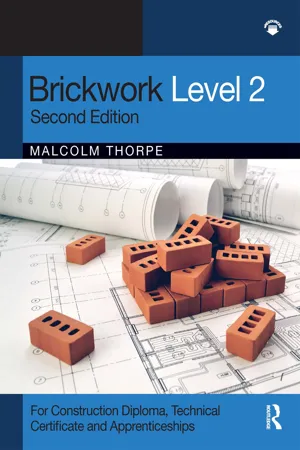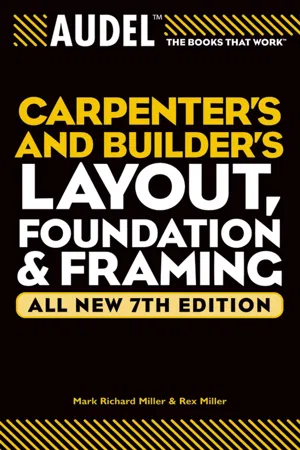Technology & Engineering
Brick and Block Construction
Brick and block construction refers to the use of bricks and concrete blocks as primary building materials. This construction method involves laying bricks or blocks in a specific pattern and bonding them together with mortar. It is a popular and durable construction technique used in residential, commercial, and industrial buildings.
Written by Perlego with AI-assistance
Related key terms
1 of 5
4 Key excerpts on "Brick and Block Construction"
- eBook - ePub
- Andrew J. Charlett, Craig Maybery-Thomas(Authors)
- 2013(Publication Date)
- Routledge(Publisher)
7 Bricks and Blocks IntroductionThe basic components of construction for walls are bricks, blocks and stones. Because blocks are more porous than bricks and therefore not as weather resistant, and because stones tend to be more expensive than bricks for house wall construction in most parts of the United Kingdom, it is usual to select bricks for external wall construction and blocks for internal wall construction. Cavity walls generally have a brick external leaf and a block internal leaf. This chapter will consider the main materials used for brick manufacture and compare their physical characteristics. Similarly the main materials and types of block will also be considered along with their physical characteristics. Building stones will not be considered.Bricks Bricks are manufactured from three basic raw materials:- clay
- calcium silicate
- concrete.
- Classification by use – common bricks have acceptable strength, water absorption, durability, thermal and moisture movement, thermal conductivity, and sound insulation performance characteristics, but they are cheaply produced and their appearance is poor. They can therefore be specified in locations where they will not be seen in the finished wall. Sometimes this may mean that the wall is constructed from common bricks and is then covered with an external and internal facing material such as render and plaster. Facing bricks, on the other hand, are more expensive to produce and their appearance is much better and they can therefore be used in positions where they will be seen. Their performance characteristics in all other respects are similar to those for common bricks. Engineering bricks, as the name suggests, are stronger than common or facing bricks and have lower moisture absorption characteristics. They too are more expensive than common bricks and are specified for use where their enhanced strength and low porosity are important, for example below ground in footings. Their appearance is not particularly appealing and they would therefore tend to be used in areas where they cannot be seen.
- eBook - PDF
- Malcolm Thorpe(Author)
- 2021(Publication Date)
- Routledge(Publisher)
Bricks The study of bricks, from raw materials to delivery of finished products, is an extensive one. Construction Technology 131 ddddddd Being able to recognize a brick when it appears on site, know its properties such as shape, size, weight, strength, porosity and colour – and therefore know how and where to use it correctly – is all important basic knowledge. Brick making is a very skilful business, with many individual variations in methods of manufacture between companies and their factories. British Standards specify a brick as a walling unit designed to be laid in mortar and not more than 337.5 mm long, 225.0 mm wide and 112.5 mm high, as distinct from a building block which is explained as a unit having one or more of these dimensions larger than those quoted for bricks. Bricks, which are one of the most durable materials, can be described as building units which are easily handled with one hand. There are numerous uses for bricks but the main ones are as units laid in mortar to form walls and piers and, increasingly, for brick paving. Bricks were first made many thousands of years ago in hot climates, where a clay mixture was moulded and dried in the sun. It was found that if the clay mixture was heated to a high temperature, the bricks were much stronger. The basic method of making bricks has not fundamentally changed. Variety Whether made from clay, sand and lime or concrete, bricks may be divided into four broad varieties: facings, commons, engineering bricks and refractories. Facing bricks These are made in a wide variety of colours and surface textures so as to be durable and attractive to look at. Commons These are for general-purpose walling that is most likely to be below ground level, externally rendered or internally plastered. They are not given particu- larly attractive surface features, but are hard and durable. - eBook - PDF
Construction Technology
An Illustrated Introduction
- Eric Fleming(Author)
- 2009(Publication Date)
- Wiley-Blackwell(Publisher)
1 Masonry Construction in Bricks and Blocks Bricks and blocks standards and dimensions 2 Bricks 2 Terminology 2 Brick sizes 2 Nominal sizing 3 Durability of bricks 3 Mortar joints 3 Coordinating sizes 3 Types of brick by shape 4 Kinds of brick by function 4 Brick materials 5 Testing of bricks 5 The bonding of bricks to form walls 5 Convention on thicknesses of walls 8 Types of bond 9 Vertical alignment 14 Honeycomb brickwork 16 Quoins – an alternative definition 16 Half brick thick walls 16 Frog up or frog down 17 ‘Tipping’ 17 Common and facing brickwork 18 Facing brickwork 18 Pointing and jointing 19 General principles of bonding 21 Blocks 22 Block materials 22 Concrete blocks 22 Dense and lightweight concretes 23 Autoclaved aerated concrete 23 Dimensions of standard metric block 23 Whys and wherefores of mortar 25 Cement 25 Lime 26 Sand 27 Water 27 Which mortar mix? 27 ‘Fat’ mixes 28 General rules for selection of mortar 29 Mortar additives 30 Mixing in additives 30 Mixing mortar 31 Good or bad weather 32 Why should we be starting a book on building construction with a discussion of bricks and blocks? Quite simply because bricks are one of the major construction materials instantly as-sociated with construction in the mind of the novice or lay person, but more importantly because the sizes chosen for the manufacture of bricks and blocks affect practically every-thing in a building except the thickness of the coats of paint or the coats of plaster. This will be discussed in more detail as we proceed. Bricks and blocks are entirely ‘man-made’ masonry units. A variety of materials are quarried, mined or salvaged from manufac-turing processes and made into bricks or blocks. Stone is quarried and shaped but occurs naturally and was often used as it was found below cliffs or outcrops or on beaches, or from the general stones on or in the ground. Artificial stone and reconstructed stone are ‘man-made’. - Mark Richard Miller, Rex Miller(Authors)
- 2005(Publication Date)
- Audel(Publisher)
Chapter 5 Concrete-Block Construction Concrete blocks (or cement blocks , as they are also known) provide suitable building units. By the use of standard-size hollow blocks, walls can be erected at a very reasonable cost and are durable, light in weight, fire-resistant, and able to carry heavy loads. The term concrete masonry is applied to building units molded from concrete and laid by masons in a wall (see Figures 5-1 and 5-2). The units are made of Portland cement, water, and suitable ag-gregates (such as sand, gravel, crushed stone, cinders, burned shale, or processed slag). The units are laid in a bed of cement mortar. Figure 5-1 Two-core masonry block being installed. (Courtesy of Bilco Company.) 73 74 Chapter 5 TOP 4 FT 0 IN. UN-REINFORCED 6 FT 0 IN. MAXIMUM WALL HEIGHT LOWER 2 FT 0 IN. REINFORCED 8 IN. 1 FT 4 IN. CROSS-SECTION OF GARDEN WALL 18 IN. MINIMUM DEPTH GROUND LINE FILL CORE SPACES AROUND BAR WITH CONCRETE CAP BLOCK TWICE THICKNESS OF WALL FOOTING FOR 8 IN. WALLS FOOTING BELOW FROST LINE 1 FT 4 IN. 8 IN. SAME AS WALL THICKNESS GRADE 1 / 2 IN. REINFORCING BARS AT 4 FT. CENTERS IF WALL IS MORE THAN 4 FT. HIGH. 8 IN. 8 IN. 16 IN. CONCRETE BLOCK Figure 5-2 Cross-section and view of a simple block wall. Verti-cal reinforcement rods are placed in the hollow cores at various intervals. Block Building Materials The two key materials used in concrete block construction are the standard blocks themselves (available in various sizes and shapes) and the mortar used to bind the blocks together. Standard Masonry Units Concrete blocks are available in many sizes and shapes (see Fig-ure 5-3). They are all sized based on multiples of 4 inches. The fractional dimensions shown allow for the mortar (see Figure 5-4). Some concrete blocks are poured concrete made of standard ce-ment, sand, and aggregate. An 8-inch × 8-inch × 16-inch block weighs about 40–50 pounds.
Index pages curate the most relevant extracts from our library of academic textbooks. They’ve been created using an in-house natural language model (NLM), each adding context and meaning to key research topics.



